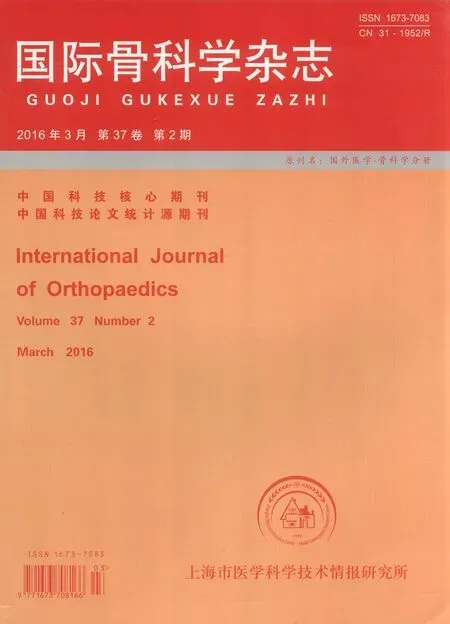Hedgehog信号转导通路与软骨细胞
肖良 徐宏光
241001 安徽芜湖, 皖南医学院附属弋矶山医院脊柱骨科
Hedgehog信号转导通路与软骨细胞
肖良徐宏光
241001安徽芜湖,皖南医学院附属弋矶山医院脊柱骨科
摘要大量研究表明,Hedgehog(Hh)信号转导通路的异常激活与多种骨关节软骨慢性退行性疾病相关。Hh基因包括Sonic hedgehog(Shh)、 Indian hedgehog(Ihh)和Desert hedgehog(Dhh)。Ihh在软骨内成骨不同时期通过不同途径调控软骨细胞的分化发育,维持骨稳定生长;Shh主要促进胚胎时期肢体和脊髓中的骨髓间充质干细胞(BMSC)向软骨细胞分化;BMSC成软骨分化是一个复杂的过程,各信号通路虽然可单独起作用,但共同发挥调控作用更为重要。该文就Hh信号转导通路分类及构成、Hh信号转导通路与软骨细胞分化和发育、Hh信号转导通路与软骨退变等方面作一综述。
关键词Hedgehog信号转导通路;软骨细胞;调控机制
脊椎动物骨髓间充质干细胞(BMSC)成骨途径包括膜内成骨和软骨内成骨,其中软骨内成骨为主要成骨方式,其主要通过软骨的形成与退化、骨组织逐渐替代软骨组织等方式成骨。研究表明,Hedgehog(Hh)信号转导通路为调控机体发育的重要信号通路[1],除了参与成骨过程中软骨形成和骨化外,还与多种骨关节疾病的发生发展关系密切。因此,揭示Hh信号转导通路在软骨发育与退变中的内在机制对预防和治疗骨疾病具有重大潜在价值。本文就Hh信号转导通路与软骨细胞研究进展作一综述。
1Hh信号转导通路分类及构成
哺乳动物体内Hh基因包括3种同源基因: Sonic hedgehog(Shh)、Indian hedgehog(Ihh)和Desert hedgehog(Dhh),其编码的蛋白质前体经分子内裂解、脂质化等形成含有N末端和C末端的多聚体,其中N末端具有传递信号的功能[2]。Hh配体形成后可作用于相应细胞膜受体。Hh信号转导通路在细胞膜上的受体为Patched(Ptc)和Smoothened(Smo),其中Ptc为12 次跨膜蛋白,对信号通路起负性调节作用;Smo为特殊的7 次跨膜蛋白,是信号通路激活所必需的受体之一。当无Hh配体存在时,Ptc 通过结合Smo来抑制其活性,转录激活因子Gli蛋白(包括Gli1、Gli2、Gli3,其中Gli1 和Gli2 起激活作用,Gli3 起抑制作用)与微管结合蛋白形成复合体并附着在微管上无法进入细胞核,Gli逐渐被蛋白激酶A(PKA)磷酸化,最终被蛋白酶分解[3]。分解产物GliR是一种转录抑制因子,可抑制细胞核中Hh靶基因的转录。当存在编码的Hh配体时,Hh配体会与Ptc 受体结合,解除其对Smo的抑制。释放的Smo 与Cos2、Fu 结合形成复合物,同时抑制PKA 活性,从而抑制Gli的分解,有利于完整的Gli进入细胞核,激活相应Hh靶基因[4-6]。
2Hh信号转导通路与软骨细胞分化和发育
2.1Ihh调控软骨细胞分化
在BMSC增殖和成软骨分化过程中,Ihh起着重要的调控作用[7-8]。软骨细胞肥大化是软骨内骨化过程中的关键步骤。大量研究表明,Ihh通过甲状旁腺激素相关蛋白(PTHrP)途径来调节软骨细胞分化。多数学者[9]认为,Ihh通过与PTHrP形成负反馈轴来影响软骨分化,即由肥大前软骨细胞分泌Ihh诱导PTHrP合成,PTHrP再作用于效应细胞膜受体甲状旁腺激素(PTH)/PTHrP受体(PPR),从而抑制局部区域内软骨细胞持续肥大,使其保持增殖状态,同时通过PKA途径负向调控Ihh表达,最终使BMSC向成软骨细胞分化,抑制其肥大老化[9]。当PTHrP合成降低至一定水平时,软骨细胞则会停止增生并肥大化[10]。Ihh缺乏时,PTHrP合成减少,进一步促进软骨细胞肥大老化[11]。研究[12]发现,除调节BMSC向成软骨细胞分化外,Ihh还进一步参与了滑膜关节软骨的形成及维持。但也有学者发现,在含PTHrP-/-个体的软骨组织或软骨细胞内,当Ihh蛋白过表达时,仍可使软骨细胞肥大,但当Hh特异性抑制剂环靶明存在或Smo被移除时,软骨细胞肥大则发生延迟。以上现象提示,Ihh 可能不依赖PTHrP 途径来促进软骨细胞肥大,但其具体调控机制尚未阐明。Choi等[13]研究发现,Ihh可通过调节Wnt信号转导通路降解Nkx3.2蛋白,进而促进软骨肥大,而Nkx3.2 蛋白能促进软骨细胞早期分化和维持细胞存活,并且抑制软骨细胞凋亡。综上所述, Ihh在软骨内成骨不同时期通过不同途径调控软骨细胞的分化发育,维持骨稳定生长。
2.2Shh调控软骨细胞分化
Shh虽然与Ihh互为同源蛋白,但在调节软骨细胞分化过程中发挥不同作用[14]。Shh主要促进胚胎时期肢体和脊髓中的BMSC向软骨细胞分化。研究[15]发现,前体节中胚层Shh通过骨形态发生蛋白(BMP)信号转导通路促使Nkx3.2和Sox9形成自调节回路,继而调控软骨细胞分化与增殖,且对分化晚期有特异性作用。Shh对软骨细胞早期形成也有重要作用,可使软骨细胞特异性胞外基质Ⅱ型胶原蛋白和聚集蛋白聚糖(AGC)合成增加[16]。研究[17]发现,苍术内酯Ⅲ通过上调Shh信号,激活转录因子Gli1入核,进而促进成软骨分化及维持软骨表型,当Shh信号被阻断时,该作用明显减弱。
2.3Hh信号转导通路与其他信号转导通路串话调控软骨细胞分化
多项研究[18-20]表明,Hh信号转导通路与其他信号转导通路之间存在广泛串话,如 Hh信号转导通路在转化生长因子(TGF)-β、BMP和Wnt/β-catenin等信号转导通路上游调控BMSC成软骨分化。早期软骨细胞形成中,Ihh与Runx基因关系密切,上调的Gli1蛋白能激活Runx2和Runx3表达,协同促进BMSC向成软骨细胞分化[21]。此外,多种软骨细胞肥大和终末分化调节因子如维生素 D3、纤维母细胞生长因子受体-3等也通过与Ihh 相互影响发挥作用[22-23]。 Shh可诱导Nkx3.2来调控Runx的表达,从而维持软骨细胞表型和胞外基质分泌[24]。综上所述,BMSC成软骨分化是一个复杂的过程,各信号通路虽然可单独起作用,但通过串话共同发挥调控作用更为重要。
3Hh信号转导通路与软骨退变
软骨退变与多种慢性骨关节疾病密切相关,如骨关节炎(OA)、类风湿关节炎(RA)、椎间盘退变等[25-27]。软骨退变的实质为软骨细胞的异常分化,与软骨内成骨过程中的软骨细胞分化阶段类似,均经历细胞肥大、终末分化、矿化,最终凋亡的过程。正常软骨细胞主要分泌Ⅱ型胶原蛋白和AGC,当软骨细胞发生退变时,则特异性分泌Ⅹ型胶原蛋白、基质金属蛋白酶(MMP)-13和蛋白聚糖酶促进软骨钙化[28]。胚胎发育成熟后, Hh信号转导通路进入沉默状态,当机体处于病理状态(如缺血、组织损伤和力学载荷失衡等)时,则会被再次激活[29]。近年来有学者发现Hh信号转导通路的异常活化对软骨退变发生发展具有重要作用。Wei等[30]研究发现,在OA的软骨和关节液中Ihh表达明显增高,且增高程度与软骨细胞肥大相关基因MMP-13 和Ⅹ型胶原蛋白表达程度呈正相关,用siRNA转染和环靶明作用于软骨细胞抑制Hh信号转导通路,结果Ⅹ型胶原蛋白和MMP-13表达下调。因此,在人OA软骨中,Ihh信号转导通路的激活可促进软骨细胞肥大并上调MMP-13表达,进而导致软骨结构的破坏。Runx2在成骨细胞分化和软骨细胞成熟过程中必不可少。Amano等[31]研究发现,Hh信号转导通路通过下游转录因子Gli结合Runx2来实现软骨细胞中Ⅹ型胶原蛋白的转录和表达,从而使软骨出现钙化。Wang 等[32]研究发现,与急性椎体骨折患者相比,椎间盘退变患者的终板软骨内Hh信号转导通路明显激活,Ⅹ型胶原蛋白和MMP-13表达明显增高,且表达量与软骨退变程度呈正相关;为了进一步明确相关机制,利用siRNA转染抑制Ihh表达,发现软骨细胞内转录因子Gli1、Gli2、Gli3、Runx2、MMP-13、Ⅰ型胶原蛋白、Ⅹ型胶原蛋白含量减少,Ⅱ型胶原蛋白明显增加,而当质粒重组过表达Ihh后,结果正好相反,因此认为Hh信号转导通路在椎间盘退变的终板软骨细胞内通过减少Ⅱ型胶原蛋白和增加软骨肥大钙化标志物Ⅰ型胶原蛋白、Ⅹ型胶原蛋白的方式促进软骨细胞退变。Ali等[33]研究发现,Hh信号转导通路调控软骨细胞内胆固醇的动态平衡,Gli转录水平提高时,可引起软骨细胞内胆固醇异常聚集,进而加重OA。综上所述,Hh信号转导通路在慢性骨关节疾病软骨病理形成过程中具有重要促进作用。
4展望
Hh信号转导通路对于胚胎时期软骨细胞的发育和胚胎成熟后软骨细胞功能的调控都至关重要,先天性缺失或后天性异常激活都会促使机体产生各种疾患,但其具体调控机制目前仍不明确。外界刺激激活Hh信号转导通路方式、Hh信号转导通路被激活后使软骨细胞发生病理改变机制也有待进一步解答。软骨细胞自然形成和软骨表型维持需要多种信号分子、信号通路协调运作,因此Hh信号转导通路与其他信号转导通路的串话机制亦将成为研究BMSC成软骨分化领域的热点。此外,软骨细胞生长发育也离不开外周生长环境及生物力学因素影响。目前对于软骨细胞的研究多将信号调控与外界环境刺激分开进行,今后的研究应注重BMSC和软骨细胞生长的物理化学环境,建立细胞、器官以及在体动物等相关模型,为进一步探究软骨细胞生长发育和退变机制提供新的思路和方法。
参考文献
[ 1 ]Nusslein-Volhard C, Wieschaus E. Mutations affecting segment number and polarity in drosophila[J]. Nature, 1980, 287(5785):795-801.
[ 2 ]Gradilla AC, Guerrero I. Hedgehog on the move: a precise spatial control of hedgehog dispersion shapes the gradient[J]. Curr Opin Genet Dev, 2013, 23(4):363-373.
[ 3 ]Liem KF Jr, He M, Ocbina PJ, et al. Mouse Kif7/Costal2 is a cilia-associated protein that regulates sonic hedgehog signaling[J]. Proc Natl Acad Sci USA, 2009, 106(32):13377-13382.
[ 4 ]Humke EW, Dorn KV, Milenkovic L, et al. The output of hedgehog signaling is controlled by the dynamic association between suppressor of fused and the gli proteins[J]. Genes Dev, 2010, 24(7):670-682.
[ 5 ]Tukachinsky H, Lopez LV, Salic A. A mechanism for vertebrate hedgehog signaling: recruitment to cilia and dissociation of SuFu-Gli protein complexes[J]. J Cell Biol, 2010, 191(2):415-428.
[ 6 ]Li ZJ, Nieuwenhuis E, Nien W, et al. Kif7 regulates Gli2 through Sufu-dependent and independent functions during skin development and tumorigenesis[J]. Development, 2012, 139(22):4152-4161.
[ 7 ]Wu X, Li SH, Lou LM, et al. The effect of the microgravity rotating culture system on the chondrogenic differentiation of bone marrow mesenchymal stem cells[J]. Mol Biotechnol, 2013, 54(2):331-336.
[ 8 ]Worthley DL, Churchill M, Compton JT, et al. Gremlin 1 identifies a skeletal stem cell with bone, cartilage, and reticular stromal potential[J]. Cell, 2015, 160(1-2):269-284.
[ 9 ]Fischer J, Dickhut A, Rickert M, et al. Human articular chondrocytes secrete parathyroid hormone-related protein and inhibit hypertrophy of mesenchymal stem cells in coculture during chondrogenesis[J]. Arthritis Rheum, 2010, 62(9):2696-2706.
[10]Zhao Q, Brauer PR, Xiao L, et al. Expression of parathyroid hormone-related peptide (PthrP) and its receptor (PTH1R) during the histogenesis of cartilage and bone in the chicken mandibular process[J]. J Anat, 2002, 201(2):137-151.
[11]Vortkamp A, Lee K, Lanske B, et al. Regulation of rate of cartilage differentiation by Indian hedgehog and PTH-related protein[J]. Science, 1996, 273(5275):613-622.
[12]Fischer J, Aulmann A, Dexheimer V, et al. Intermittent PTHrP(1-34) exposure augments chondrogenesis and reduces hypertrophy of mesenchymal stromal cells[J]. Stem Cells Dev, 2014, 23(20):2513-2523.
[13]Choi SW, Jeong DU, Kim JA, et al. Indian hedgehog signalling triggers Nkx3.2 protein degradation during chondrocyte maturation[J]. Biochem J, 2012, 443(3):789-798.
[14]张雪萍,马晓丽,汪运山,等. 大鼠骨髓间充质干细胞成骨分化过程中Hedgehog信号分子的表达[J]. 中国组织工程研究与临床康复, 2011, 15(14):2487-2490.
[15]Zeng L, Kempf H, Murtaugh LC, et al. Shh establishes an Nkx3.2/Sox9 autoregulatory loop that is maintained by BMP signals to induce somitic chondrogenesis[J]. Genes Dev, 2002, 16(15):1990-2005.
[16]Warzecha J, Gottig S, Bruning C, et al. Sonic hedgehog protein promotes proliferation and chondrogenic differentiation of bone marrow-derived mesenchymal stem cells in vitro[J]. J Orthop Sci, 2006, 11(5):491-496.
[17]Li X, Wei G, Wang X, et al. Targeting of the sonic hedgehog pathway by atractylenolides promotes chondrogenic differentiation of mesenchymal stem cells[J]. Biol Pharm Bull, 2012, 35(8):1328-1335.
[18]Iwakura T, Inui A, Reddi AH. Stimulation of superficial zone protein accumulation by hedgehog and Wnt signaling in surface zone bovine articular chondrocytes[J]. Arthritis Rheum, 2013, 65(2):408-417.
[19]Hojo H, Ohba S, Taniguchi K, et al. Hedgehog-Gli activators direct osteo-chondrogenic function of bone morphogenetic protein toward osteogenesis in the perichondrium[J]. J Biol Chem, 2013, 288(14):9924-9932.
[20]Keller B, Yang T, Chen Y, et al. Interaction of TGFβ and BMP signaling pathways during chondrogenesis[J]. PLoS One, 2011, 6(1):e16421.
[21]Kim EJ, Cho SW, Shin JO, et al. Ihh and Runx2/Runx3 signaling interact to coordinate early chondrogenesis: a mouse model[J]. PLoS One, 2013, 8(2):e55296.
[22]Klotz B, Mentrup B, Regensburger M, et al. 1,25-dihydroxyvitamin D3 treatment delays cellular aging in human mesenchymal stem cells while maintaining their multipotent capacity[J]. PLoS One, 2012, 7(1):e29959.
[23]Grande DA, Mason J, Light E, et al. Stem cells as platforms for delivery of genes to enhance cartilage repair[J]. J Bone Joint Surg Am, 2003, 85(Suppl 2):111-116.
[24]Kawato Y, Hirao M, Ebina K, et al. Nkx3.2-induced suppression of Runx2 is a crucial mediator of hypoxia-dependent maintenance of chondrocyte phenotypes[J]. Biochem Biophys Res Commun, 2011, 416(1-2):205-210.
[25]Zhou J, Wei X, Wei L. Indian hedgehog, a critical modulator in osteoarthritis, could be a potential therapeutic target for attenuating cartilage degeneration disease[J]. Connect Tissue Res, 2014, 55(4):257-261.
[26]Zhou J, Chen Q, Lanske B, et al. Disrupting the Indian hedgehog signaling pathway in vivo attenuates surgically induced osteoarthritis progression in Col2a1-CreERT2; Ihhfl/fl mice[J]. Arthritis Res Ther, 2014, 16(1):R11.
[27]Razzak M. Osteoarthritis: the hedgehog and the bony spur[J]. Nat Rev Rheumatol, 2012, 8(3):123.
[28]van der Kraan PM, van den Berg WB. Chondrocyte hypertrophy and osteoarthritis: role in initiation and progression of cartilage degeneration?[J]. Osteoarthritis Cartilage, 2012, 20(3):223-232.
[29]van Hook AM. Focus issue: fine-tuning Hedgehog signaling in development and disease[J]. Sci Signal, 2011, 4(200):eg10.
[30]Wei F, Zhou J, Wei X, et al. Activation of Indian hedgehog promotes chondrocyte hypertrophy and upregulation of MMP-13 in human osteoarthritic cartilage[J]. Osteoarthritis Cartilage, 2012, 20(7):755-763.
[31]Amano K, Densmore M, Nishimura R, et al. Indian hedgehog signaling regulates transcription and expression of collagen type Ⅹ via Runx2/Smads interactions[J]. J Biol Chem, 2014, 289(36):24898-24910.
[32]Wang S, Yang K, Chen S, et al. Indian hedgehog contributes to human cartilage endplate degeneration[J]. Eur Spine J, 2015, 24(8):1720-1728.
[33]Ali SA, Al-Jazrawe M, Ma H, et al. Regulation of cholesterol homeostasis by hedgehog signaling in osteoarthritic cartilage[J]. Arthritis Rheumatol, 2016, 68(1):127-137.
(收稿:2015-09-22;修回:2015-11-21)
(本文编辑:李圆圆)
DOI:10.3969/j.issn.1673-7083.2016.02.008
通信作者:徐宏光E-mail: xuhg@medmail.com.cn
基金项目:国家自然科学基金(81272048)

